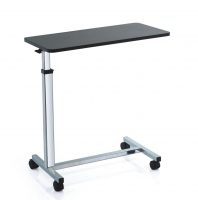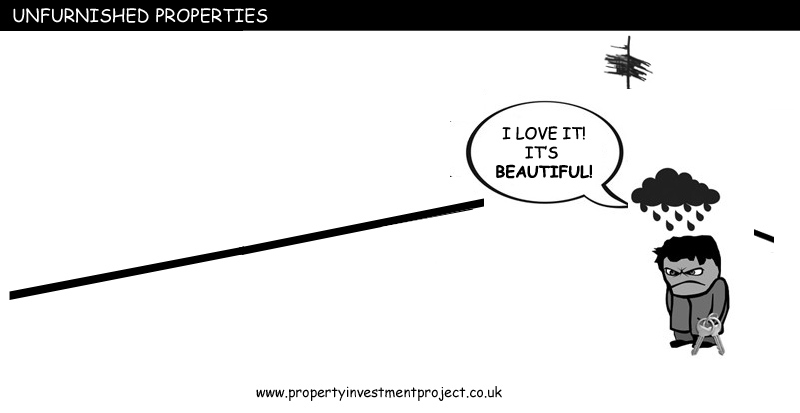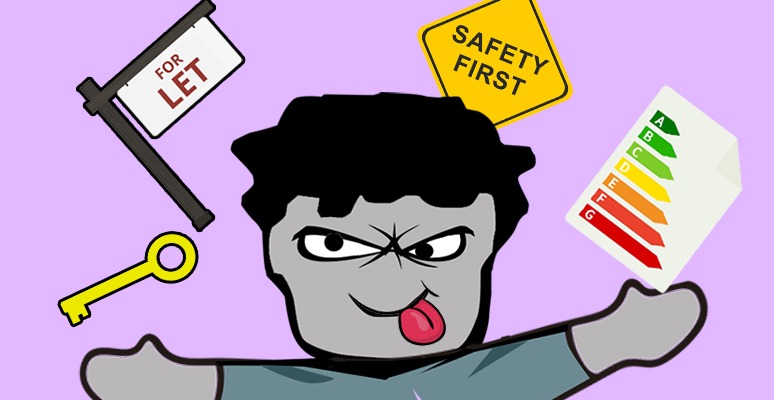
Holy moly. The gaps between my blog posts are getting dangerously long now!
D’know what the funny thing is? To help boost my horrendously low productivity levels I recently purchased a ‘disability over-bed table’ – yes, just like the ones you see in hospitals and nursing homes next to the piss-filled bedpans.
Here you go, check it:

Long story short, my new purchase clearly didn’t help with productivity, but it does segue me nicely onto the topic of furniture (specifically, what furniture should landlords provide with their properties)! Silver-lining, innit?
What furnishings should landlords provide in a BTL?
My answer: None (kinda’).
Failing that, assuming there’s a gun the size of a dinosaur pointing at your head, provide the very bare minimum. My general rule of thumb is to always keep it simple.

To be honest, I’m not even going to try and do the honourable thing by being objective about the issue; I’m going to be a complete ignoramus- this will be going all one way.
While I’m sure many of you can provide glowing furniture-based success stories, I can say through personal experience that for the most part, none of the pros outweigh the long-term reasons for avoiding the practice like a pile of dogshit. In 97% of cases, providing furniture doesn’t make any sense. I’m actually surprised so many landlords provide furnished properties, and I say that on the basis that the vast majority don’t do it, and with impeccably good reasoning.
1) Increasing responsibility & maintenance costs
Let’s sling the obvious out of the way.
Mo’ furniture, mo’ problems.
I’m sure many landlords can quickly and actively make their lives a lot less difficult and expensive by removing the unnecessary fittings and furnishings they pointlessly provided in their BTL. Not mid-tenancy obviously (although that would be hilarious), but next time round.
The blatantly obvious point to remember is that the more you provide with your property, the more you’re making yourself responsible for; the more reasons you’re creating to be called upon when something falls on its knees and crumbles into disrepair. Each item you provide is like a loaded gun. If that concept doesn’t make you want to burn your furniture to ashes, nothing will.
I’ve discussed ‘minimising risks’ before (although I can’t remember in which posts for the life of me), particularly the benefits it can have on our health and profits, and how we should be looking to do it across the board with every decision; from finding tenants to furniture and fittings. MINIMISE RISK!
I think we can all agree that being contacted by a tenant because, for example, a £20 Ikea bedside table (…or a cool disability table) is ‘wonky’ and in need of maintenance sounds irritating beyond belief- and that’s because it is. It only gets more infuriating when it actually happens. So why put yourself in that position where you’re prone to that kind of senseless attack?
How many of you have actually been summoned because of a broken item that you actually didn’t need to provide in the first place for a successful let?
2) Disputes over damage and theft
I hear too many disputes about broken furniture and responsibilities. Not to mention, it’s not unheard of for items of furniture to miraculously go walkabouts. Either way, it’s usually such a gigantic waste of time
Generally, the tight-fisted landlord is the first to point blame for a broken item and the tenant is just as quick to deny all acknowledgement, so you end up with two disgruntled and unreasonable assholes pointing fingers at one another. That’s no fun.
The situation then escalates onto the tenancy deposits dispute resolution protocol, in which case the tenant almost always wins, usually because the landlord failed to compile a reliable inventory, or because the damage gets drawn up as fair wear and tear (even when it’s not).
You’ll be a blubbering mess then, won’t you?
Really, what’s the bloody point?
3) It’s easier to sell/dump the furniture
This is just so typical. Humans are natural born hoarders.
Landlords can’t be arsed to dispose of old/unwanted furniture, or they store items in their BTL believing they’ll call upon them in the future for personal use. However, the latter rarely ever happens, just like when we store junk in our lofts for later use, it almost always inevitably remains to collect mountains of dust and/or succulent rat-food.
Ultimately, you’re left with a delusional landlord that believes s/he’s hitting two birds with one stone; free storage and extra incentive for tenants. In reality, the hassle of providing furniture will trump both the mentioned illusionary benefits.
Again, you’re creating more responsibility and maintenance unnecessarily. Either sell or dump your unwanted furnishings; stay clear from transforming your BTL into a storage unit for your own shit.
4) Furniture gets worn/out-dated
Furniture can be alienating if it’s total junk or doesn’t suit your prospective tenants taste, especially if it’s out-dated, worn or cheap. And if it’s not out-dated, it will be soon enough.
One of the best ways of minimizing void periods is to make your property suitable for as many prospective tenants as possible, furniture generally does the opposite, it creates limitations because you’re now catering to taste.
5) Void from Council Tax Exemption
Depending on the politics of your local council, you may or may not be able to benefit from council tax relief during void periods. However, generally, exemption is usually always unavailable for furnished properties, because in theory, the property is still in ‘in use’… albeit, a glorified storage unit.
In real terms, if you have a furnished BTL property vacant for a month, you may have to pay the full £100 (approx) council tax fee.
6) Responsibility to restock
Over time, through historic and wisdom-filled events, you may realise that some furnishings and fittings are more prone to fair wear and tear than others, so you intelligently come to the conclusion that it doesn’t make any economic sense to continue restocking/repairing those items.
However, you stupidly sold your property on the basis that it comes with those items, so that means you need to ensure your property always has those items in exchange for the agreed rent…
What a glorious waste of money. What a freakin’ pickle.
7) Most rentals are unfurnished
If most rental properties are unfurnished, that means most tenants will have their own furniture and look for unfurnished properties. From my experience, most tenants want to transfer their own furniture, as opposed to selling their own before relocating, so they naturally look for ‘unfurnished’.
So again, you will drastically reduce the amount of interest in your property if you’re providing furniture, which could create longer and unnecessary vacant periods.
However, I will say one thing, in this booming rental market, where getting on the property ladder is near impossible for the average Joe, there shouldn’t be any real difficulties filling any type of vacant property, despite using ‘furnished property’ as bait. But it is a smaller audience, that’s all I’m saying.
8) The extra rent achieved doesn’t usually stack-up
This is my main gripe with providing furniture, the fact it usually doesn’t generate any extra income in the long-run. I’d actually go as far as to say it costs more by eating into profits.
Sure, you can charge more for furnished properties, but the extra you make usually won’t compensate for 1) the added time required to repair and maintain 2) the extra overall cost for maintenance 3) longer vacant periods 4) the increased potential for disputes 5) the extra admin required e.g. a more comprehensive inventory.
I’ve even gone as far as paying extra to remove features like a fireplace or air-con units, because I know that over the duration they’ll cost more than they’ll make me. That’s the key, calculating how much money the furniture will actually make you.
But let’s be real, furniture adds very little intrinsic value, if any.
9) Part-furnished is even more stupid than full-furnished
From what I understand, there’s no real legal definition of what constitutes as ‘furnished’, ‘part-furnished’ or ‘unfurnished’. But as a general consensus, we can assume that part-furnished implies a few randomly provided items like a table and a chest of drawers, minus a sofa, chairs and beds, just for example.
Opting for part-furnished is probably the dumbest biggest mistake of all potential scenarios, and it usually occurs because of my previous point, where landlords use their BTL’s as storage units.
The reality is, those part-furnishings won’t warrant or generate a single penny in extra rent, and will provide ZERO extra incentive to convince prospective tenants to pick your property over a completely unfurnished property- a singular chest of drawers tucked away in a bedroom corner won’t have any impact, and you’re probably clinically insane if you think otherwise.
So the question has to be asked, WHY provide the random part-furnishings items? If the furniture isn’t making you money, it’s costing you money! Don’t fall victim to using your BTL as a storage unit, stick your shit on ebay or take a trip to your local dump…. or just start a fire and vaporize it all. Burn it all to the ground (safely and responsibly).
It has to be said, I’ve been guilty of this crime to some extent. I remember I used to leave random pieces of furnishings and fittings in my properties, usually clean/useful items that were left behind by previous tenants, stupid items like garden plant pots. In hindsight, I was just opening myself up for senseless attacks.
Now I ensure my tenants remove ALL their belongings during checkout. Any form of excess fat is a liability. Keep it lean and clean!
10) Contents Insurance
Depending on the quantity and value of the furniture provided, it may make good sense to extend your standard landlord building insurance to cover contents.
More costs. More costs. And more costs.
11) It’s cheaper not to buy furniture in the first place
I’m not entirely sure why this reason popped into my puny mind at the closing stages of my list- I may currently be dangerously dehydrated- because it probably should have been at the top. It’s so obvious.
Forget escalating repair and maintenance costs for a moment, let’s go back to the very beginning, where buying furniture in the first place requires more start-up capital.
If you really need to spend that money (I have no idea why that would be the case, maybe some dumb tax surplus benefit, or something), it can definitely be spent in better areas. For example, I’d rather spend my hard-earned money on a workhorse boiler that will withstand the test of time. Trust me, the tenant will benefit far more, whether he/she realises it or not.
12) Tenants that buy their own furniture stay longer
Moving is a pain for everyone. Period.
I can think of a billion other sadistic and painful things I’d rather do to myself than pack all my shit up and move.
It could be argued that tenants with their own furniture will be more inclined to stay longer, purely because the prospect of moving is that much more profusely sickening (and potentially expensive). I’m not just talking about the agony of lugging it around, but also furniture is typically purchased to fit around specific room dimensions, and often retrofitted to make the perfect fit. Furniture can act like shackles in that sense! Brilliant.
Of course, this could either be an incredibly good or bad thing. But generally, we all want long-term tenants as long as they’re not utter idiots.
If a tenant’s worldly possessions consists of clothing and a few appliances and can be contained in a few boxes, there isn’t much of a barrier to relocate.
13) Encourages D.I.Y idiocy
The last thing a tenant wants to do is sacrifice their deposit because of a broken piece of furniture, and who can blame them?
Hello “bodge-job repairs”!
Tenants will do almost anything to recover their deposit in its entirety, and that includes patching together a broken table leg with a bit of pritt-stick. It’s usually good enough to fool the landlord on first inspection, but the reality often surfaces after the deposit has been returned and the in-between cleaning/tidying preparation commences. If you’re terribly unlucky, it will bypass your inspection, and the next set of tenants will fall victim to a collapsing table while indulging in spag-bol, and now they’re angry at the piece of shit furniture you provided.
Not good!
14) Can’t afford to furnish… what does that mean?
I’m not sure how fair this final point is, but I can see the logic behind it, so I’m going to toss it onto the pile, even if it’s just food for thought.
If a tenant is prepared to rent a £1,200PCM 2 bedroom property, but makes it clear they can’t afford to furnish, it could give you a good inclination of their state of finances. This could be a dangerously poor assumption to make, but something about the concept makes sense, especially when put into the right context. So unfurnished properties could act as a detoriant for tenants that don’t have much disposable income.
So there you have it, 14 solid reasons to fuck furniture right off, right?
I hear the pro-furniture brigade are like animal-rights activists, a proper lively bunch, so go easy on me if I triggered any chemically imbalanced rage. Despite popular belief, I’m here to love. Hard & fast.
The exceptions…
I can think of a few scenarios where providing furnishings can make sense, but generally speaking, these account for a very small portion of landlords in the grand scheme of things, and cover areas of landlording which I have no involvement with…
Short-term home let
If you’re looking to let your own home for a short-period, for 6-18 months, because you’re having a mid-life crisis and consequently wanting to travel the world, it can make sense to leave all the furniture in there. But don’t for one second expect them to be in the same condition as you left it.
No one will care about your precious possessions as much as you do, and that means no one will care if your chest of draws is an inherited family heirloom. It’s just another shitty chest of draws to everyone else.
4+ bedroom house
I’m not all that familiar with larger bedroom BTL properties. I don’t think they make for good rental investments, I think the sweet-spot is anywhere between 1-3 bedrooms. However, I can’t imagine many private tenants looking for a 4+ bedroom will have the means or urge to furnish such large properties, purely because of the ball-ache involved. For those without furniture, it could mean an extra 2k investment.
So if you’re letting a large property, it can make sense to furnish it. Having said that, since more and more people are being completely priced out of the market, including many families (that come with their own furniture), I suspect that larger rental properties are becoming more sought after, especially in ‘family-friendly’ neighborhoods.
So who knows, maybe unfurnished 4+ bedroom properties have hope. If so, definitely go for it (I would).
Shared accommodation
HMOs are almost always fully furnished, similarly with properties that comprise of live-in landlords and lodgers.
Holiday lets
This goes without saying, and it’s a completely different kettle of fish from standard BTL’s.
By all means, furnish your quaint little cottage in the Cotswolds with your best china and Grandpa’s rocking chair.
Student lets
I guess this accounts for not only students, but also people in their early-mid twenties too, both of whom usually don’t have the experience or means to come attached with their own possessions beyond a camping bag full of grungy clothing, and a couple of novelty shot glasses.
To be more specific, I’d say this applies to flats in student/trendy areas that attract the youth by the masses, areas like Shoreditch and Bricklane- areas my sprouting grey hairs would stick out like a bunch of sore thumbs. Sigh.
Whatever the exception, I’d keep the furniture to a bear minimum. And it’s always worth asking, “will providing furniture actually make a difference to the rentability?” In many cases, it won’t.
What I actually do provide in terms of fittings & furnishing…
Most of the following does not constitute as “furniture” in my opinion, but I do want to make the distinct clarification, just in case some plonker walks away from here with completely the wrong idea- they wouldn’t be the first…
- White goods
‘White goods’ are pretty essential, and can make all the difference to desirability.Most rentals come with some form of white goods, and it’s unlikely a tenant will want to splash out an extra £1k to buy their own. I’m sure they’d rather spend that extra money on a better property that comes with them supplied.
I typically provide a fridge-freezer in my properties, I believe most tenants expect that at the very least. Anything more and you’ll notice a difference in maintenance costs and ’emergency calls’ from your tenants, because white goods are usually used and relied upon regularly (e.g. washing machines), so they’re prone to breakage, and when that happens, you’ll be the first to know.
- Oven/Cooker
All my properties have built in or free-standing cooker/oven combo- pretty standard as far as I’m concerned.Does anyone actually go without providing an oven/cooker? That’s taking ‘unfurnished’ to the next level. If so, may as well get your tenants to supply their own toilet, too.
- Beds
I can get on board with providing beds, particularly within certain demographics, like flats in a student/trendy area. At least, providing a bed in the master bedroom should be enough.I think they can make a useful addition, and generally, a good sturdy bed won’t just collapse and die, so the investment won’t be excruciating. Of course, the good thing about beds is that they can mostly be styled by the duvet, so they shouldn’t cause any offense.
Since everyone needs/wants a bed, it’s one of those features that can play a factor in winning over the crowd. However, mattresses, that’s another issue altogether, their life-cycle is horrendously short as they generally get covered in all kinds of congealed shit. Literally. So if I do provide a bed, it comes without a mattress.
- Curtains/Blinds
Believe me, it’s better that you properly fit curtain rails and provide neutral curtains yourself, as opposed to leaving it in the capable hands of your heavy-handed tenants. From my experience, that’s a sure-fire way of repossessing your property with nasty gaping holes above the window frames.I provide curtains with erectile joy (I have no idea what I actually mean by that, but assume it’s inappropriate).
- Bathroom mirror and bathroom fittings
For the same reasons as providing curtain rails, I provide a bathroom mirror. There are a few other fittings that can fall under the same scenario – inexpensive items that all tenants will inevitably need, so it’s easier/safer just to provide them- but it usually depends on a case-by-case basis, so I’ll leave it to your better judgement.
So, what are your thoughts? Do you provide furniture? Can you think of any other reasons to avoid furniture like the plague?
If you’re one of the weird ones that do provide furniture, I’d also love to hear your stance (“love” is probably a grossly inaccurate description, but either way, go for it)!
Landlord out xo
Disclaimer: I'm just a landlord blogger; I'm 100% not qualified to give legal or financial advice. I'm a doofus. Any information I share is my unqualified opinion, and should never be construed as professional legal or financial advice. You should definitely get advice from a qualified professional for any legal or financial matters. For more information, please read my full disclaimer.


 Landlord Products / Services
Landlord Products / Services






























I let my properties unfurnished, just the w/m and fridge freezer as you've described. These are Brighton flats. I've not once been asked to provide anything other and sometimes a tenant will ask for a w/m to be removed if they have their own. I'm definitely in the keep it simple/ reduce the liability camp on this one.
I like the blog. Thanks.